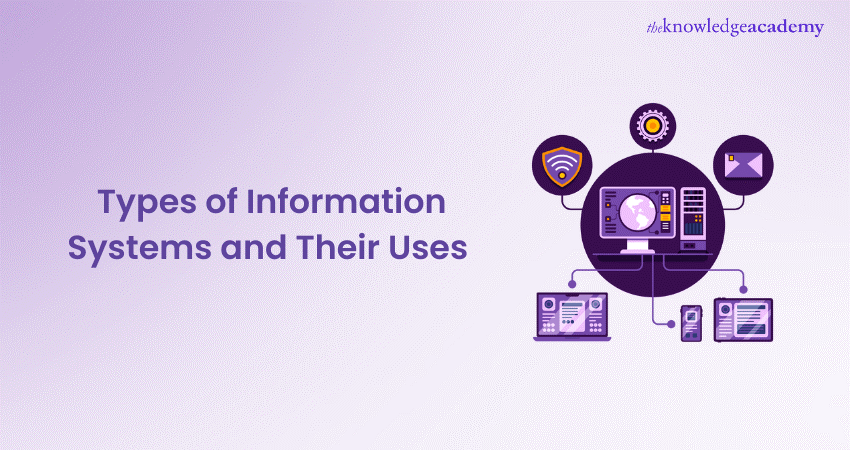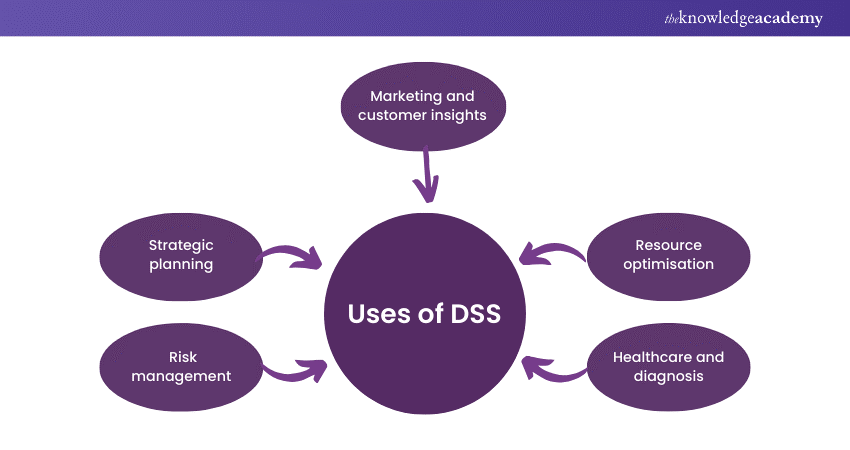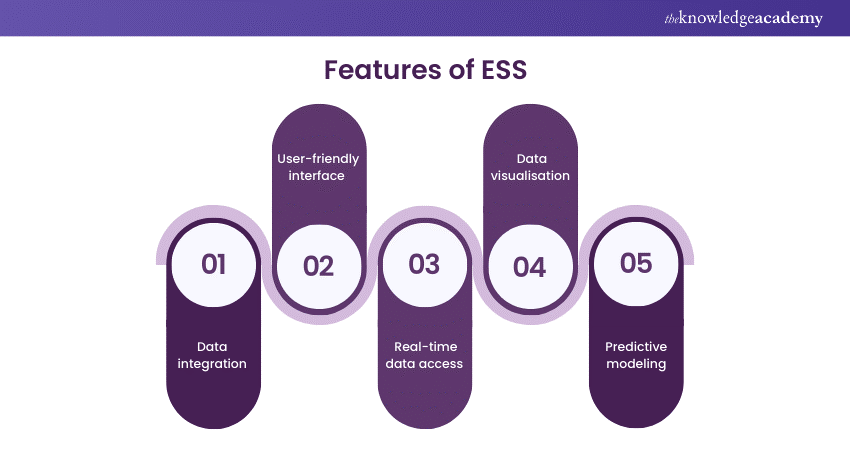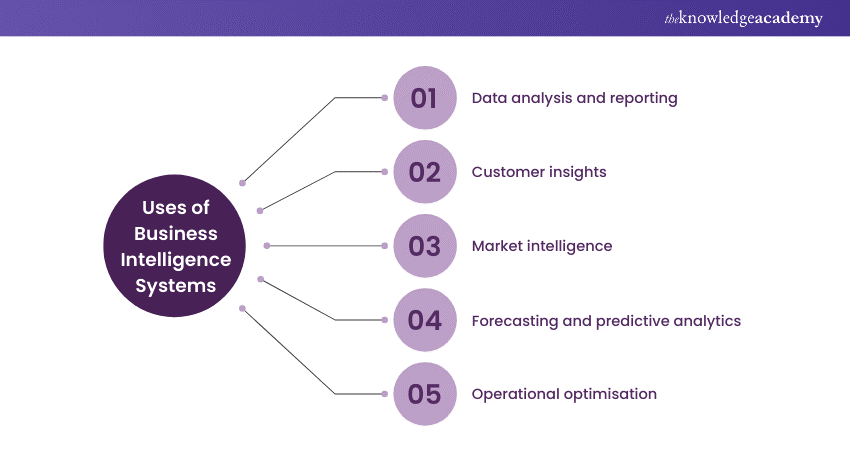We may not have the course you’re looking for. If you enquire or give us a call on +44 1344 203 999 and speak to our training experts, we may still be able to help with your training requirements.
We ensure quality, budget-alignment, and timely delivery by our expert instructors.

In this digital world, Information Systems form the backbone of businesses, enabling efficient operations, informed decision-making, and strategic planning. Companies of all sizes are focusing on Information Systems for proper collecting, storing, processing, and distributing information within organisations and beyond. There are various Types of Information Systems which ensure the smooth operations in the management.
According to The Business Research Company, the global market of Information Technology (which is also used as a synonym for Information Systems) grew from £6723.45 billion in 2022 to £7276.59 billion in 2023. As you can see, companies from all around the world are investing massive amounts in this industry to make their businesses more technology-forward. In this blog, you are going to learn about the different Types of Industry Systems and their various uses, which help industries become more technologically advanced.
Table of Contents
1) Importance of Information Systems in modern businesses
2) What are the Types of Information Systems?
a) Transaction Processing Systems (TPS)
b) Management Information Systems (MIS)
c) Decision Support Systems (DSS)
d) Executive Support Systems (ESS)
e) Office Automation System
f) Business Intelligence Systems
3) Conclusion
Importance of Information Systems in modern businesses
Information Systems streamline business operations by automating processes, managing data efficiently, and ensuring seamless communication within and outside the organisation. They enhance decision-making processes by providing timely, accurate, and relevant information to managers and executives, enabling them to make informed choices that drive the company's growth.
Moreover, Information Systems facilitate improved customer service and engagement. Through Customer Relationship Management (CRM) systems and Data Analytics, businesses can understand customer preferences, anticipate demands, and personalise interactions, leading to enhanced customer satisfaction and loyalty. It also plays a pivotal role in supply chain management, optimising inventory, logistics, and distribution processes.
Additionally, it also enhances organisational flexibility, allowing businesses to adapt to market trends swiftly. They foster innovation by providing a platform for research, development, and the implementation of new ideas.
Want to learn how to manage Information Systems Security? Then register in our Information Systems Security Management Training!
What are the Types of Information Systems?
There are six main Types of Information Systems. They are as follows:

Transaction Processing Systems (TPS)
Transaction Processing Systems (TPS) ensures seamless flow of data and transactions within organisations. TPS is a computerised system that processes, records, and monitors transactions in real time. These transactions can include anything from sales and purchases to inventory management, payroll processing, and order fulfilment.
1) Essential components and functions:
At the heart of TPS lie several vital components, including databases, servers, and software applications designed to record transactions instantly. When a transaction occurs, TPS captures the pertinent data, processes it according to predefined rules, and stores the resulting information in a centralised database. This rapid processing is vital, especially in sectors where time-sensitive actions are crucial.
2) Uses of TPS in modern businesses:
a) Retail Operations: In retail, TPS ensures swift and accurate processing of sales transactions. It manages inventory levels in real time, triggering reorder requests when stocks run low, thus preventing shortages and ensuring customer satisfaction.
b) Banking and finance: Banks rely on TPS for handling numerous transactions daily, including deposits, withdrawals, fund transfers, and loan processing. TPS guarantees accuracy, security, and speed, thereby enhancing customer trust in financial institutions.
c) Online commerce: E-commerce platforms handle a vast number of transactions daily. TPS manages online purchases, updates product availability, processes payments securely, and tracks shipments, ensuring a seamless shopping experience for customers.
d) Healthcare: TPS is instrumental in managing patient records, appointments, billing, and insurance claims. It enhances efficiency in healthcare facilities, ensuring that medical professionals have instant access to vital patient information.
e) Transportation and logistics: TPS optimises supply chain operations, helps in tracking the movement of goods, manages inventory levels, and processes orders. This is particularly vital for businesses engaged in global trade, enabling them to coordinate complex logistics with precision.

Management Information Systems (MIS)
Management Information Systems (MIS) is another Types of Information Systems, where it bridges the gap between raw data and strategic decision-making. MIS is a comprehensive framework that leverages technology to gather, process, store, and disseminate information to support managerial functions within an organisation. It serves as the backbone of modern management, ensuring that decision-makers are equipped with accurate, timely, and relevant data to steer their organisations toward success.
1) Key components and functions:
MIS comprises various elements, including databases, software applications, hardware resources, and skilled personnel. These components collaborate to collect vast amounts of data from diverse sources, such as transaction processing systems, and transform this data into meaningful information. Through data analysis and reporting tools, MIS provides executives and managers with insightful summaries, forecasts, and performance metrics, aiding in strategic planning and tactical decision-making processes.
2) Uses of MIS in modern businesses:
a) Strategic planning: MIS plays a vital role in long-term planning by providing executives with comprehensive insights into market trends, customer behaviour, and competitor activities. This strategic foresight allows businesses to identify opportunities, mitigate risks, and formulate effective business strategies.
b) Performance monitoring: MIS enables the continuous monitoring of Key Performance Indicators (KPIs) and other metrics crucial to evaluating the organisation’s performance. Managers can identify areas of improvement, assess the effectiveness of strategies, and make data-driven decisions to enhance overall efficiency.
c) Resource management: MIS optimises resource allocation by analysing data related to human resources, finances, inventory, and production. This ensures that resources are utilised efficiently, reducing wastage and enhancing productivity.
d) Decision support: MIS empowers managers by providing them with ad hoc reports, data visualisations, and predictive analytics. These tools aid in scenario analysis and 'what-if' modelling, allowing managers to simulate various business scenarios and assess the potential outcomes of different decisions.
e) Communication and collaboration: MIS facilitates seamless communication and cooperation between departments and teams within an organisation. By providing a centralised platform for information sharing, MIS enhances teamwork, accelerates problem-solving, and fosters innovation.
Decision Support Systems (DSS)
Decision Support Systems (DSS) are sophisticated computer-based applications designed to assist decision-makers in solving complex problems and making strategic choices. By harnessing advanced analytics, data modelling, and artificial intelligence, DSS provide invaluable insights, enabling managers to navigate uncertainties, explore alternatives, and make well-informed decisions.
1) Key components and functions:
DSS consists of a range of components, including databases, analytical models, user interfaces, and decision engines. These components synergise to analyse vast datasets, identify patterns, and generate meaningful reports. It often employs technologies such as data mining, predictive modelling, and machine learning algorithms to gather trends and forecast outcomes. The intuitive interfaces allow decision-makers to interact with the system, posing queries and exploring scenarios to gain deeper insights into complex problems.
2) Uses of DSS in modern businesses:

a) Strategic planning: DSS aids executives in strategic planning by providing in-depth analyses of market trends, competitor strategies, and customer behaviours. By simulating various scenarios, decision-makers can assess the potential impact of different methods, enabling the selection of the most viable and lucrative options.
b) Risk management: DSS is instrumental in risk assessment and management. By analysing historical data and current market conditions, DSS can identify potential risks, allowing organisations to develop proactive strategies to mitigate these risks effectively.
c) Resource optimisation: DSS optimises resource allocation by analysing factors such as demand patterns, production capacities, and supply chain logistics. By identifying bottlenecks and inefficiencies, organisations can streamline their operations, reduce their overall costs, and enhance overall productivity.
d) Marketing and customer insights: DSS analyses customer data to identify preferences, purchasing patterns, and feedback. This information is important for crafting targeted marketing campaigns, personalised customer experiences, and improving customer satisfaction.
e) Healthcare and diagnosis: In the healthcare sector, DSS aids medical professionals in diagnosing diseases and recommending treatments. By analysing patient data and comparing it with vast medical databases, DSS enhances the accuracy of diagnoses, leading to improved patient outcomes.
Enhance your cybersecurity expertise and fortify your organisation against digital threats. Sign up now for our Cyber Security Training!
Executive Support Systems (ESS)
Executive Support Systems (ESS) is another important Types of Information Systems, which is designed to assist senior management in strategic decision-making processes. Tailored to the needs of high-level executives, it provides comprehensive information from internal and external sources, enabling leaders to analyse trends, assess organisational performance, and formulate long-term strategies.
1) Essential components and functions:

ESS integrates data from various sources, including internal databases, market intelligence, and competitor analyses. Utilising advanced analytical techniques and intuitive visualisation tools, ESS presents information in the form of concise reports, charts, and graphs. Its user-friendly interface allows executives to explore data effortlessly, enabling them to delve deep into critical aspects of the business environment.
2) Uses of ESS in modern businesses:
a) Strategic decision-making: ESS assists executives in making strategic decisions by providing a holistic view of the organisation's performance metrics, market trends, and competitive landscapes. By analysing this data, leaders can identify emerging opportunities, anticipate threats, and devise strategies to achieve long-term objectives.
b) Performance monitoring: It tracks KPIs and benchmarks organisational performance against predefined goals. Executives can monitor real-time data, enabling them to assess progress, identify areas of improvement, and align the organisation's efforts with its strategic vision.
c) Scenario analysis: It facilitates scenario planning by allowing executives to simulate various business scenarios. By altering variables such as market demand, pricing strategies, or production capacities, executives can assess the potential outcomes of different decisions, aiding in risk mitigation and strategic planning.
d) Competitor analysis: ESS provides in-depth insights into competitors' activities, market positioning, and product strategies. By understanding the competitive landscape, executives can fine-tune their strategy, identify market gaps, and develop offerings that stand out in the industry.
e) Communication and collaboration: ESS enhances communication and collaboration among top executives. By providing a centralised platform for accessing relevant information, it ensures that all executives are on the same page, fostering cohesive decision-making processes.
Want to learn about the fundamentals of System and Network Security? Sign up now for our Introduction to System and Network Security Training!
Office Automation System
Office Automation Systems (OAS) have become essential tools for businesses aiming to enhance productivity, streamline workflows, and foster collaborative work environments. It refers to the integration of computer hardware, software, and network connections to optimise routine office tasks and facilitate efficient information management. By automating mundane and time-consuming processes, it helps employees focus on more strategic and creative aspects of their work, ultimately driving organisational success.
1) Key components and functions:
OAS includes a range of applications such as word processing software, spreadsheets, email systems, calendar and scheduling tools, and document management platforms. These components automate tasks like document creation, data analysis, appointment scheduling, and communication, reducing manual effort and minimising errors. OAS also incorporates collaborative features, allowing multiple users to work on shared documents in real time, fostering seamless teamwork.
2) Uses of Office Automation Systems:
a) Document management: OAS facilitates the creation, editing, and sharing of documents, enabling teams to collaborate effortlessly. Version control features ensure that everyone works on the latest document iteration, promoting consistency and accuracy.
b) Email and communication: It integrates email systems, enabling efficient IT Communication Strategy within and outside the organisation. It also automates email responses, schedules appointments, and organises meetings, ensuring smooth correspondence and coordination among team members.
c) Data analysis: Spreadsheets and data processing tools within OAS automate complex calculations, data analysis, and reporting. This is particularly valuable for financial analysis, budgeting, and forecasting, allowing businesses to make data-driven decisions.
d) Task automation: OAS automates repetitive tasks such as data entry, form submissions, and report generation. By eliminating manual labour, employees can focus on more strategic tasks, boosting overall productivity.
e) Collaborative work: OAS platforms enable real-time collaboration on projects, fostering teamwork among geographically dispersed teams. Features like shared calendars, collaborative editing, and instant messaging enhance communication and coordination.
f) Workflow automation: It streamlines workflows by automating approval processes, task assignments, and document routing. This reduces delays, minimises errors, and ensures that tasks progress smoothly through various stages.
Business Intelligence Systems
Business Intelligence Systems (BIS) encompasses a set of technologies, applications, and processes that analyse and transform raw data into insights which are meaningful. This helps businesses to gain a comprehensive understanding of their operations, customers, and market dynamics. By employing advanced analytics and data visualisation techniques, BIS empowers organisations to make informed decisions, identify patterns, and forecast trends, thereby gaining a competitive edge in the fast-paced business landscape.
1) Key components and functions:
BIS comprises data warehousing, data mining, reporting tools, dashboards, and predictive analytics. These components work in harmony to gather data from various sources, cleanse and transform it into usable formats, and then analyse it to provide actionable insights. Through interactive dashboards and detailed reports, it presents complex data in visually understandable formats, allowing decision-makers to interpret information swiftly and accurately.
2) Uses of Business Intelligence Systems:

a) Data analysis and reporting: BIS enables in-depth analysis of historical and real-time data, providing detailed reports on various aspects of business performance. This analysis helps businesses track KPIs, assess operational efficiency, and identify areas for improvement.
b) Customer insights: BIS tools analyse customer data to identify purchasing patterns, preferences, and behaviours. By understanding customer needs, businesses can tailor their products and services, enhance customer experiences, and improve customer retention rates.
c) Market intelligence: It gathers and analyses market data, enabling businesses to monitor market trends, track competitors' activities, and identify emerging opportunities. This intelligence is invaluable for strategic planning and staying ahead of market shifts.
d) Forecasting and predictive analytics: BIS employs predictive modelling to predict future trends based on previous data. This capability aids businesses in demand forecasting, inventory management, and financial planning, ensuring proactive decision-making.
e) Operational optimisation: It optimises operational processes by analysing workflow efficiencies and identifying bottlenecks. By streamlining operations, businesses can reduce costs, enhance productivity, and improve overall business agility.
f) Strategic decision-making: Ultimately, BIS empowers strategic decision-making. By providing executives with timely and accurate insights, BIS supports leaders in formulating business strategies, allocating resources effectively, and positioning the organisation for sustainable growth.
Conclusion
These different Types of Information Systems help streamline transactions and aid decisions in fostering innovation, and these systems are the bedrock of organisational success. From this blog, you may have understood these types and how they can be used in businesses to obtain optimum results.
Frequently Asked Questions
What are the Other Resources and Offers Provided by The Knowledge Academy?

The Knowledge Academy takes global learning to new heights, offering over 3,000 online courses across 490+ locations in 190+ countries. This expansive reach ensures accessibility and convenience for learners worldwide.
Alongside our diverse Online Course Catalogue, encompassing 19 major categories, we go the extra mile by providing a plethora of free educational Online Resources like News updates, Blogs, videos, webinars, and interview questions. Tailoring learning experiences further, professionals can maximise value with customisable Course Bundles of TKA.
Upcoming IT Security & Data Protection Resources Batches & Dates
Date
 CISSP Certification
CISSP Certification
Mon 17th Mar 2025
Mon 26th May 2025
Mon 14th Jul 2025
Mon 22nd Sep 2025
Mon 24th Nov 2025
Mon 8th Dec 2025






 Top Rated Course
Top Rated Course


 If you wish to make any changes to your course, please
If you wish to make any changes to your course, please


